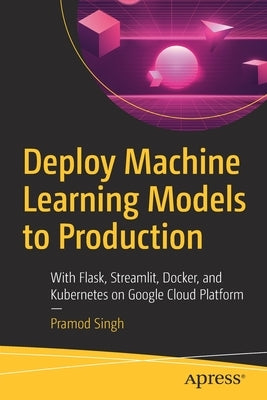Description
Chapter goal: This chapter covers the steps right from reading the data, pre-processing, feature engineering, model training and prediction on local as well as on the cloud. This chapter provides the audience with a set of required libraries and code/data download information so that the user can set up their environment appropriately. Sub -Topics
- Configuring your development environment
- Installing required libraries
- Building Python and TensorFlow based models Chapter 2: Introduction to Model Deployment and Challenges
No of pages: 20
Chapter goal: The chapter showcases what is meant by deployment and what are the challenges associated with it.
Sub - Topics
- Understanding model deployment
- Understanding challenges
- Serverless architecture for deployment Chapter 3: Model Deployment Using Flask
No of pages: 25
Chapter goal: This chapter covers the lightweight web framework - Flask for deploying the small and simple machine learning models. Sub - Topics:
- What is Flask
- Build Python-based model
- Deploy machine learning model using Flask Chapter 4: Model Containerization Using Docker
No of pages:30
Chapter goal: This chapter is devoted to the understanding of docker platform. It covers all the steps to containerize any model, application using docker. Sub - Topics:
- Introduction to Docker
- Build a custom Docker image
- Run a machine Learning model using Docker Chapter 5: Introduction to Kubeflow
No of pages:30 Chapter goal: This chapter serves as an introduction to our core theme of the book: Build and deploy machine learning models using Kubeflow. The chapter begins with covering various components of Kubeflow and offers information on its advantages over other platforms
Sub - Topics:
- Gentle Introduction to Kubernetes
- Introduction to Kubeflow
- Kubeflow components Chapter 6: Model Deployment Using Kubeflow
No of pages: 35 Chapter goal: This chapter focuses on the industrial implementation of deep learning model in the Google Cloud Platform using Kubeflow. This chapter also demonstrates various techniques like hyperparameter tuning and workflows for training and serving the models for predictions
Sub - Topics: - Google Cloud Platform configuration
- Hyperparameter tuning of the model
- Training and serving model at scale Chapter 7: Model Deployment Using MLflow No of pages:20
Chapter goal: This chapter covers the alternative to Google's Kube
Author: Pramod Singh
Publisher: Apress
Published: 01/01/2021
Pages: 150
Binding Type: Paperback
Weight: 0.53lbs
Size: 9.21h x 6.14w x 0.35d
ISBN13: 9781484265451
ISBN10: 1484265459
BISAC Categories:
- Computers | Languages | Python
- Computers | Artificial Intelligence | General
- Computers | Programming | Open Source
About the Author
Pramod Singh is Manager of Data Science at Bain & Company. Previously, he worked as Sr. Machine Learning Engineer at Walmart Labs and Data Science Manager at Publicis Sapient in India. He has spent over 10 years working in machine learning, deep learning, data engineering, algorithm design, and application development. He has authored three Apress books: Machine Learning with PySpark, Learn PySpark, and Learn TensorFlow 2.0. He is a regular speaker at major conferences such as O'Reilly's Strata Data, GIDS, and other AI conferences. He is an active mentor and faculty in machine learning and AI at various educational institutes. He lives in Bangalore with his wife and four-year-old son. In his spare time, he enjoys playing guitar, coding, reading, and watching football.

